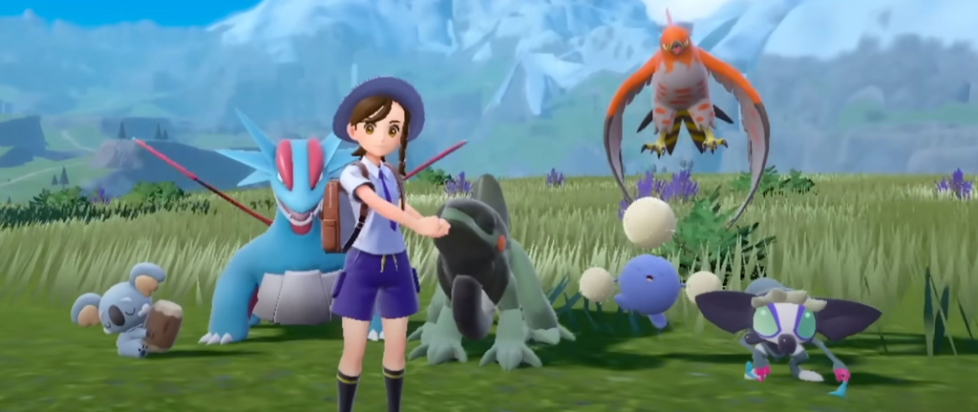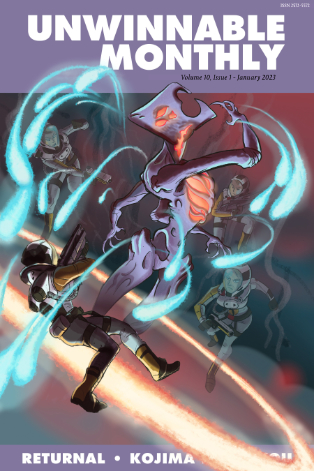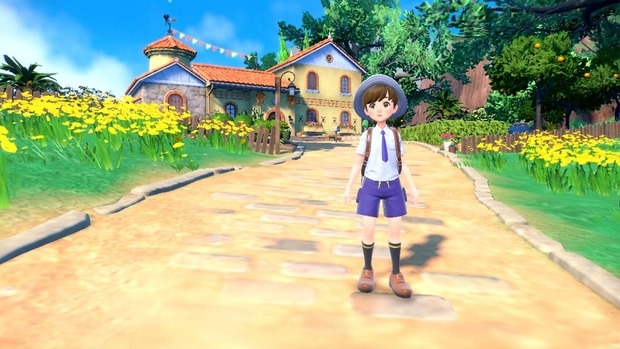
“The Abundant Nature”

This column is a reprint from Unwinnable Monthly #159. If you like what you see, grab the magazine for less than ten dollars, or subscribe and get all future magazines for half price.
———
What does digital grass feel like?
———
I wanted to clown on Pokémon Scarlet and Violet from the second I saw the “abundant nature” trailer.
Obviously, that’s not actually what the trailer is called, but it lodged in my brain like that. In fact, I thought that it was my first impression of the game because of how it stuck with me, but it’s actually from the “World Overview” from August 2022 – the third of the major hype videos that dropped in the lead up to its November release.
Still, the only thing I remembered from Scarlet and Violet’s advertisement cycle was the shot where they cut to a deeply bland outdoor scene overlaid with the phrase in question. Sanitized rock cliffs painted on top with monochrome, too-bright grass and a handful of trees. Abundant nature. Easy pickings for a column like this.
But Paldea, the Iberia-inspired region introduced in the latest entry in the series, really does have abundant nature. The geometry of the world itself isn’t particularly interesting – the cliffs are just rock, without a moss or lichen in sight, the grass is a monoculture, trees are carefully placed to construct paths or points of interest. But this is also the first entry in the almost 30-year-old franchise where you can feel that it was inspired by childhood experiences of bug catching.
Although Pokémon Arceus took a swing at the open world format earlier in 2022, it fell flat with repetitive Pokémon appearances and wide, dull areas. In comparison, Scarlet and Violet feels, well, abundant.
It has less to do with the density or variety of spawns, and more to do with how carefully they’re considered. Pokémon don’t just appear in a specific area but have a habitat. Eevee’s Pokédex will tell you that it likes to be near towns and cities, and so hunting by the edges of settlements makes sense, rather than wandering onto a random route that is apparently somehow ecologically sequestered from the next one over.
And speaking of the Pokédex, Scarlet and Violet’s entries lean into the interconnected world that now exists in the game itself. One of the most popular previous Pokémon interactions was Seviper and Zangoose, who were said to have an ongoing feud. But Scarlet and Violet are packed full of these kinds of notes. Tarountula has a webbed body to protect it from Scyther attacks. Fletchinder uses embers to scare bug Pokémon out of hiding. Rufflet may peck at Spewpa, but Spewpa uses black powder created in its body to fight back.
The combination of experiencing Pokémon in the overworld, in their homes rather than scattered almost at random, and the Pokédex treating them with the depth that keen kids could previously only imagine makes Pokémon actually live up to its hunting and catching roots.

Which is why it’s so noticeable that the advertisement clearly wanted to highlight this, but completely failed to do so.
Sure, it’s hard to capture the sense of actually moving through the world in a brief trailer. Feeling the context of the Pokémon by where they appear and what flavor text they’re given isn’t something that can easily be splashed into a video for a couple of seconds. But there’s also the problem of the format of advertising itself. Something created to sell has a different understanding of abundance than something created to emulate childhood experiences of the outdoors.
But the advertisement also feels held back by the game’s own limited understanding of its ecological step forward. In Barbara Bender’s Stonehenge: Making Space, she reflects on the portrayal of a “British landscape” on a rail poster. The advertisement makes the space into something to be observed while passing through on the way to more important things. So too does the “abundant nature” trailer. And the game struggles with the same issue.
Although it has three story branches that can be completed in whatever order the player chooses. At the beginning of the game, an NPC asks which you want to prioritize, and I chose completing the Pokédex – i.e., researching all the critters and creatures – only to be told that wasn’t one of the three branches at all. Instead, it’s a secondary task that can be done while moving between gyms, giant Pokémon and defeating rivals.
But that’s never been what’s drawn me to Pokémon. I wanted to exist in the world, exploring the different areas and seeing how they supported different webs of life. Pokémon Scarlet and Violet are the first games that actually let you do that – but their stories and their trailers don’t quite seem to have realized it yet.
———
Jay Castello is a freelance writer covering games and internet culture. If they’re not down a research rabbit hole you’ll probably find them taking bad photographs in the woods.




